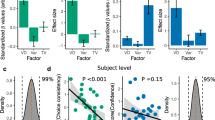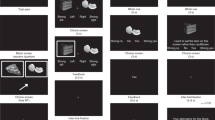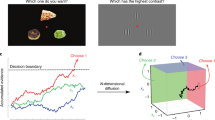Abstract
Violations of economic rationality principles in choices between three or more options are critical for understanding the neural and cognitive mechanisms of decision-making. A recent study reported that the relative choice accuracy between two options decreases as the value of a third (distractor) option increases and attributed this effect to divisive normalization of neural value representations. In two preregistered experiments, a direct replication and an eye-tracking experiment, we assessed the replicability of this effect and tested an alternative account that assumes value-based attention to mediate the distractor effect. Surprisingly, we could not replicate the distractor effect in our experiments. However, we found a dynamic influence of distractor value on fixations to distractors as predicted by the value-based attention theory. Computationally, we show that extending an established sequential sampling decision-making model by a value-based attention mechanism offers a comprehensive account of the interplay between value, attention, response times and decisions.
This is a preview of subscription content, access via your institution
Access options
Access Nature and 54 other Nature Portfolio journals
Get Nature+, our best-value online-access subscription
$29.99 / 30 days
cancel any time
Subscribe to this journal
Receive 12 digital issues and online access to articles
$119.00 per year
only $9.92 per issue
Buy this article
- Purchase on Springer Link
- Instant access to full article PDF
Prices may be subject to local taxes which are calculated during checkout





Similar content being viewed by others
Data availability
Data of all participants included in the final samples of the two experiments are publicly available on OSF (https://osf.io/qrv2e/).
Code availability
Custom code that supports the findings of this study is publicly available on OSF (https://osf.io/qrv2e/).
References
Glimcher, P. W. & Rustichini, A. Neuroeconomics: the consilience of brain and decision. Science 306, 447–452 (2004).
Carandini, M. & Heeger, D. J. Normalization as a canonical neural computation. Nat. Rev. Neurosci. 13, 51–62 (2012).
Louie, K., Grattan, L. E. & Glimcher, P. W. Reward value-based gain control: divisive normalization in parietal cortex. J. Neurosci. 31, 10627–10639 (2011).
Louie, K., Khaw, M. W. & Glimcher, P. W. Normalization is a general neural mechanism for context-dependent decision making. Proc. Natl Acad. Sci. USA 110, 6139–6144 (2013).
Savage, L. J. The Foundations of Statistics (Wiley, 1954).
Luce, R. D. Individual Choice Behavior: A Theoretical Analysis (Dover Publications, 1959).
Busemeyer, J. R., Gluth, S., Rieskamp, J. & Turner, B. M. Cognitive and neural bases of multi-attribute, multi-alternative, value-based decisions. Trends Cogn. Sci. 23, 251–263 (2019).
Huber, J., Payne, J. W. & Puto, C. Adding asymmetrically dominated alternatives: violations of regularity and the similarity hypothesis. J. Consum. Res. 9, 90–98 (1982).
Gluth, S., Hotaling, J. M. & Rieskamp, J. The attraction effect modulates reward prediction errors and intertemporal choices. J. Neurosci. 37, 371–382 (2017).
Munafò, M. R. et al. A manifesto for reproducible science. Nat. Hum. Behav. 1, 0021 (2017).
Anderson, B. A., Laurent, P. A. & Yantis, S. Value-driven attentional capture. Proc. Natl Acad. Sci. USA 108, 10367–10371 (2011).
Gluth, S., Spektor, M. S. & Rieskamp, J. Value-based attentional capture affects multi-alternative decision making. eLife 7, e39659 (2018).
Tsetsos, K., Chater, N. & Usher, M. Salience driven value integration explains decision biases and preference reversal. Proc. Natl Acad. Sci. USA 109, 9659–9664 (2012).
Glickman, M., Tsetsos, K. & Usher, M. Attentional selection mediates framing and risk-bias effects. Psychol. Sci. 29, 2010–2019 (2018).
Usher, M., Tsetsos, K., Glickman, M. & Chater, N. Selective integration: an attentional theory of choice biases and adaptive choice. Curr. Dir. Psychol. Sci. https://doi.org/10.1177/0963721419862277 (2019).
Krajbich, I., Armel, C. & Rangel, A. Visual fixations and the computation and comparison of value in simple choice. Nat. Neurosci. 13, 1292–1298 (2010).
Krajbich, I. & Rangel, A. Multialternative drift-diffusion model predicts the relationship between visual fixations and choice in value-based decisions. Proc. Natl Acad. Sci. USA 108, 13852–13857 (2011).
Forstmann, B. U., Ratcliff, R. & Wagenmakers, E.-J. Sequential sampling models in cognitive neuroscience: advantages, applications, and extensions. Annu. Rev. Psychol. 67, 641–666 (2016).
Gold, J. I. & Shadlen, M. N. The neural basis of decision making. Annu. Rev. Neurosci. 30, 535–574 (2007).
Asendorpf, J. B. et al. Recommendations for increasing replicability in psychology. Eur. J. Pers. 27, 108–119 (2013).
Simonsohn, U. Small telescopes: detectability and the evaluation of replication results. Psychol. Sci. 26, 559–569 (2015).
Kass, R. E. & Raftery, A. E. Bayes factors. J. Am. Stat. Assoc. 90, 773–795 (1995).
McFadden, D. Economic choices. Am. Econ. Rev. 91, 351–378 (2001).
Polanía, R., Krajbich, I., Grueschow, M. & Ruff, C. C. Neural oscillations and synchronization differentially support evidence accumulation in perceptual and value-based decision making. Neuron 82, 709–720 (2014).
Palminteri, S., Khamassi, M., Joffily, M. & Coricelli, G. Contextual modulation of value signals in reward and punishment learning. Nat. Commun. 6, 8096 (2015).
Fontanesi, L., Gluth, S., Spektor, M. S. & Rieskamp, J. A reinforcement learning diffusion decision model for value-based decisions. Psychon. Bull. Rev. 26, 1099–1121 (2019).
Pearson, D. et al. Value-modulated oculomotor capture by task-irrelevant stimuli is a consequence of early competition on the saccade map. Atten. Percept. Psychophys. 78, 2226–2240 (2016).
Shimojo, S., Simion, C., Shimojo, E. & Scheier, C. Gaze bias both reflects and influences preference. Nat. Neurosci. 6, 1317–1322 (2003).
Fiedler, S. & Glöckner, A. The dynamics of decision making in risky choice: an eye-tracking analysis. Front. Psychol. 3, 335 (2012).
Cavanagh, J. F., Wiecki, T. V., Kochar, A. & Frank, M. J. Eye tracking and pupillometry are indicators of dissociable latent decision processes. J. Exp. Psychol. Gen. 143, 1476–1488 (2014).
Stewart, N., Gächter, S., Noguchi, T. & Mullett, T. L. Eye movements in strategic choice. J. Behav. Decis. Mak. 29, 137–156 (2016).
Thomas, A. W., Molter, F., Krajbich, I., Heekeren, H. R. & Mohr, P. N. C. Gaze bias differences capture individual choice behaviour. Nat. Hum. Behav. 3, 625–635 (2019).
Smith, S. M. & Krajbich, I. Gaze amplifies value in decision making. Psychol. Sci. 30, 116–128 (2019).
Holper, L. et al. Adaptive value normalization in the prefrontal cortex is reduced by memory load. eneuro 4, ENEURO.0365-17.2017 (2017).
Padoa-Schioppa, C. Range-adapting representation of economic value in the orbitofrontal cortex. J. Neurosci. 29, 14004–14014 (2009).
Cox, K. M. & Kable, J. W. BOLD subjective value signals exhibit robust range adaptation. J. Neurosci. 34, 16533–16543 (2014).
Kobayashi, S., Pinto de Carvalho, O. & Schultz, W. Adaptation of reward sensitivity in orbitofrontal neurons. J. Neurosci. 30, 534–544 (2010).
Furl, N. Facial-attractiveness choices are predicted by divisive normalization. Psychol. Sci. 27, 1379–1387 (2016).
Rustichini, A., Conen, K. E., Cai, X. & Padoa-Schioppa, C. Optimal coding and neuronal adaptation in economic decisions. Nat. Commun. 8, 1208 (2017).
Chang, L. W., Gershman, S. J. & Cikara, M. Comparing value coding models of context-dependence in social choice. J. Exp. Soc. Psychol. 85, 103847 (2019).
Li, V., Michael, E., Balaguer, J., Herce Castañón, S. & Summerfield, C. Gain control explains the effect of distraction in human perceptual, cognitive, and economic decision making. Proc. Natl Acad. Sci. USA 115, E8825–E8834 (2018).
Tajima, S., Drugowitsch, J., Patel, N. & Pouget, A. Optimal policy for multi-alternative decisions. Nat. Neurosci. 22, 1503–1511 (2019).
Khaw, M. W., Glimcher, P. W. & Louie, K. Normalized value coding explains dynamic adaptation in the human valuation process. Proc. Natl Acad. Sci. USA 114, 12696–12701 (2017).
Mohr, P. N. C., Heekeren, H. R. & Rieskamp, J. Attraction effect in risky choice can be explained by subjective distance between choice alternatives. Sci. Rep. 7, 8942 (2017).
Frederick, S., Lee, L. & Baskin, E. The limits of attraction. J. Mark. Res 51, 487–507 (2014).
Spektor, M. S., Gluth, S., Fontanesi, L. & Rieskamp, J. How similarity between choice options affects decisions from experience: the accentuation-of-differences model. Psychol. Rev. 126, 52–88 (2019).
Tusche, A. & Hutcherson, C. A. Cognitive regulation alters social and dietary choice by changing attribute representations in domain-general and domain-specific brain circuits. eLife 7, e31185 (2018).
Grueschow, M., Polania, R., Hare, T. A. & Ruff, C. C. Automatic versus choice-dependent value representations in the human brain. Neuron 85, 874–885 (2015).
Ratcliff, R. & Rouder, J. N. Modeling response times for two-choice decisions. Psychol. Sci. 9, 347–356 (1998).
Mullett, T. L. & Stewart, N. Implications of visual attention phenomena for models of preferential choice. Decision 3, 231–253 (2016).
Cavanagh, S. E., Malalasekera, W. M. N., Miranda, B., Hunt, L. T. & Kennerley, S. W. Visual fixation patterns during economic choice reflect covert valuation processes that emerge with learning. Proc. Natl Acad. Sci. USA 116, 22795–22801 (2019).
Callaway, F. & Griffiths, T. Attention in value-based choice as optimal sequential sampling. Preprint at PsyArXiv https://doi.org/10.31234/osf.io/57v6k (2019).
Sims, C. A. Implications of rational inattention. J. Monet. Econ. 50, 665–690 (2003).
Towal, R. B., Mormann, M. & Koch, C. Simultaneous modeling of visual saliency and value computation improves predictions of economic choice. Proc. Natl Acad. Sci. USA 110, E3858–E3867 (2013).
Turner, B. M. et al. A Bayesian framework for simultaneously modeling neural and behavioral data. Neuroimage 72, 193–206 (2013).
Brandt, M. J. et al. The Replication Recipe: what makes for a convincing replication? J. Exp. Soc. Psychol. 50, 217–224 (2014).
Becker, G. M., DeGroot, M. H. & Marschak, J. Measuring utility by a single-response sequential method. Behav. Sci. 9, 226–232 (1964).
Mechera-Ostrovsky, T. & Gluth, S. Memory beliefs drive the memory bias on value-based decisions. Sci. Rep. 8, 10592 (2018).
Holmes, A. P. & Friston, K. J. Generalisability, random effects & population inference. Neuroimage 7, S754 (1998).
Lee, M. D. & Wagenmakers, E.-J. Bayesian Cognitive Modeling: A Practical Course (Cambridge Univ. Press, 2013).
Aiken, L. S. & West, S. G. Multiple Regression: Testing and Interpreting Interactions (SAGE, 1991).
Acknowledgements
We thank K. Louie for providing us with materials from the original study and for approving the preregistration protocol of the direct replication experiment. Further thanks go to I. Krajbich and A. Rangel for sharing their data and to I. Krajbich and J. Rieskamp for comments on an earlier version of the manuscript. S.G. was supported by a grant from the Swiss National Science Foundation (no. 100014_172761). The funders had no role in study design, data collection and analysis, decision to publish or preparation of the manuscript.
Author information
Authors and Affiliations
Contributions
All authors designed the study. N.K., M.K. and C.L.V. collected the data. All authors analysed the data. S.G. wrote the manuscript. N.K., M.K. and C.L.V. revised the manuscript.
Corresponding author
Ethics declarations
Competing interests
The authors declare no competing interests.
Additional information
Peer review information Primary Handling Editor: Marike Schiffer
Publisher’s note Springer Nature remains neutral with regard to jurisdictional claims in published maps and institutional affiliations.
Supplementary information
Supplementary Information
Supplementary Results, Supplementary Figs. 1–11, Supplementary Tables 1–4 and Supplementary References.
Rights and permissions
About this article
Cite this article
Gluth, S., Kern, N., Kortmann, M. et al. Value-based attention but not divisive normalization influences decisions with multiple alternatives. Nat Hum Behav 4, 634–645 (2020). https://doi.org/10.1038/s41562-020-0822-0
Received:
Accepted:
Published:
Issue Date:
DOI: https://doi.org/10.1038/s41562-020-0822-0
This article is cited by
-
Attribute latencies causally shape intertemporal decisions
Nature Communications (2024)
-
Cognitive load and economic decision making of smallholder farmers in China: an experimental study
Current Psychology (2024)
-
Modeling Eye Movements During Decision Making: A Review
Psychometrika (2023)
-
Evidence integration and decision confidence are modulated by stimulus consistency
Nature Human Behaviour (2022)
-
Attentional economics links value-modulated attentional capture and decision-making
Nature Reviews Psychology (2022)



